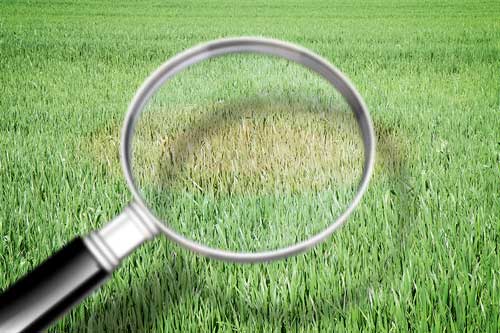A beautiful, healthy lawn doesn’t just happen overnight. It takes time, care, and—most importantly—early planning. If you want a thick, green lawn this spring, the best time to start preparing is before winter ends. With the right approach to fertilization, aeration, and weed control, you’ll set your lawn up for success before the growing season even begins.
Why You Should Start Planning Lawn Care Early
Many homeowners wait until their grass starts turning green to think about lawn care, but by then, they’ve already missed a critical window. It is important to get ahead of weeds in early spring and planning ahead makes all the difference:
- Soil temperature matters – Grass roots begin growing when soil temperatures hit about 50°F. You want to apply treatments before this happens so your lawn can absorb nutrients as it wakes up.
- Weeds don’t wait – If you’re wondering how to prevent weeds in early spring, the answer is pre-emergent weed control. These treatments work by stopping weeds before they sprout. If you wait too long, they’ll already be growing, making them harder to eliminate.
- Fertilization is most effective early – Feeding your lawn before peak growth ensures strong, healthy grass that can outcompete weeds and withstand summer heat.
Checking Your Lawn’s Condition After Winter

Inspecting your lawn after winter helps identify thatch buildup, compacted soil, thin spots, and early weed growth—key factors in planning effective spring lawn care.
Before jumping into treatments, take a close look at your lawn. Winter can leave behind some issues that need attention:
- Thatch buildup – If your lawn has more than ½ inch of thatch, nutrients and water may not be reaching the roots.
- Thin or bare spots – Areas with weak growth may need overseeding.
- Compacted soil – If your lawn feels hard and doesn’t absorb water well, aeration will help loosen it up.
- Weeds already growing – Spotting weeds early will help you decide which control methods to use.
Spring Lawn Fertilization
Applying lawn fertilizer at the right time makes all the difference in how well your grass grows. Here’s what you need to know about the best time to fertilize a lawn in the spring:
- Early Spring (March-April): Start with a balanced fertilizer to help your lawn recover from winter. A slow-release nitrogen formula is ideal.
- Mid to Late Spring (April-May): Apply a second feeding to encourage root growth and a deep green color.
The right fertilizer will depend on your soil and grass type, so if you’re unsure, a soil test can help determine what nutrients your lawn needs most.
Benefits of Aerating Lawn in Spring
Aeration is one of the best things you can do for a struggling lawn. By removing small plugs of soil, aeration allows water, air, and nutrients to reach the roots more easily. If your lawn sees a lot of foot traffic or has heavy clay soil, aeration is especially beneficial.
- Best time to aerate: Early to mid-spring for cool-season grasses; fall is ideal for warm-season grasses.
- How to aerate: A core aerator pulls out plugs of soil, loosening the ground and reducing compaction.
- After aeration: Follow up with fertilization and overseeding for the best results.
Stopping Weeds Before They Take Over
The best way to control weeds is to prevent them from growing in the first place. That’s where pre-emergent herbicides come in. These treatments stop weed seeds from sprouting, reducing the need for post-emergent weed killers later in the season.
- When to apply pre-emergents: Just before soil temperatures hit 50°F (usually late February to early April, depending on your region).
- Post-emergent options: If weeds are already growing, spot-treat them with a targeted weed killer.
- A thick lawn naturally prevents weeds: The healthier your grass, the harder it is for weeds to take hold.
Filling in Thin Spots with Overseeding

Overseeding in early spring helps fill in bare patches, promoting a thicker, healthier lawn before weeds take hold. Proper soil prep and consistent watering are key to successful growth.
If your lawn has bare patches, early spring is a great time to overseed. This helps establish new grass before weeds have a chance to take over.
- Choose the right seed: Pick a grass variety suited for your region’s climate and soil.
- Prepare the soil: Rake up debris, loosen compacted areas, and aerate if needed.
- Keep seeds moist: Water daily until the grass is established, then transition to deeper, less frequent watering.
Watering Wisely for a Healthier Lawn
Watering is one of the most overlooked parts of lawn care. Too much water can lead to disease and weak roots, while too little can stress your grass. Follow these guidelines for better results:
- Water early in the morning to reduce evaporation and prevent fungal growth.
- Water deeply but infrequently – Aim for 1 to 1.5 inches of water per week, including rainfall.
- Use a rain gauge to track natural rainfall and avoid overwatering.
Need Help? Let the Pros Handle It
Spring lawn care takes time, but the payoff is worth it. If you want to ensure your lawn gets the best possible start, consider hiring a professional. They can:
- Apply fertilizers and weed control at the right time
- Handle aeration and overseeding for better lawn density
- Create a customized plan based on your lawn’s unique needs
Aspen can take the guesswork out of lawn care. Contact us today for your Free Estimate and schedule your spring treatments and get ready for a lush, green lawn all season long!


Socials